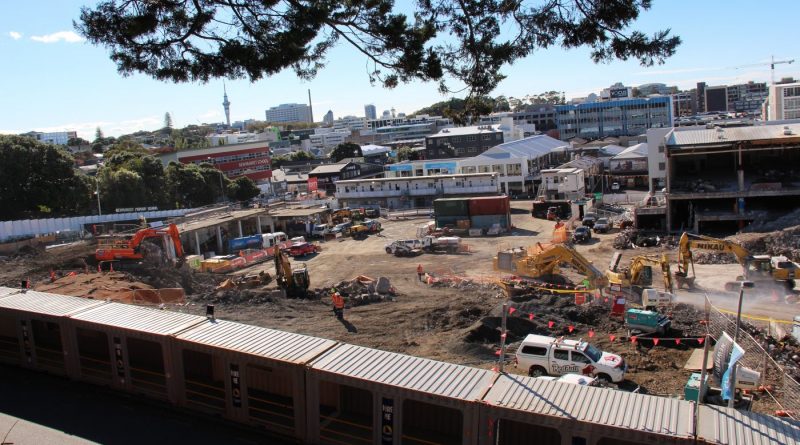Browsing: Facilities Management
Five trends in facilities management you should know about
Undergoing rapid flux as the benefits of advanced technology are brought to bear, the facilities management industry is one of the fastest growing industries in the world, with market watcher ResearchandMarkets.com putting the global value at US$35-billion in 2018 and that’s expected to hit a whopping US$59.3 billion by 2023

Auckland is also in the midst of a construction boom. According to figures from regional economic development agency ATEED (Auckland Tourism, Events and Economic Development), there are currently more than $28 billion’s worth of large construction projects underway in Auckland alone.
Break that number down further and it emerges that there are over 9,000 apartments under construction in 103 projects, 100,000 square metres of commercial office space being built or proposed in the four years to 2023, and of course there’s the New Zealand International Conference Centre going up in a $700 million project.
But just what is that change, and which trends should you be watching? Read on for the answers.
More intelligence with Internet of Things and analytics
The emergence of inexpensive sensors and dedicated networks to connect them means you can monitor just about anything. These sensors and ‘machine to machine’ information flows are known as the Internet of Things – and facilities managers recognise that remote or automated control of a wide range of building metrics makes for more efficiency and better occupant comfort. Coupled with powerful analytics tools, facilities managers are equipped with the tools for effective management of every aspect of their buildings – and automation means one facility manager can take care of tens of properties.
Green is the new gold
Property owners, and by extension facilities managers, are increasingly recognising the commercial and environmental benefits of going green. NABERSNZ and New Zealand Green Building Council ratings don’t just deliver a feel-good factor, they deliver premium rents, too. Done right, ‘green’ also delivers reduced operational costs, maximising the use of natural resources (like light, sunshine and rain) while minimising electricity and other resource usage.
Drones take flight
One of the enduring high-cost items for large-scale premises is the difficulty in keeping a consistent eye on the place. In some cases, helicopters are required for routine checks of roofs or other inaccessible places, or facades must be inspected by engineers lowered using ropes. Drones are an obvious and highly cost-effective alternative. Equipped with high-resolution cameras, drones beam images directly to the engineer, who needn’t leave his desk. It’s faster, far cheaper and provides for more frequent inspections of more of your facilities.
Intelligent automation
We’ve all seen the Roomba vacuum cleaner. Extend the concept to industrial proportions and you have robot cleaners capable of working day and night without a break. The robotic workforce combines clever software capable of handling multiple inputs and outputs (commonly called ‘Artificial Intelligence) with electronic and mechanical engineering. So far, the applications are mostly in cleaning, a job most people find abysmal. But the potential for more than janitorial tasks is obvious; in New Zealand, receptionists have already largely been replaced by a computer screen.
Smart control
The steady integration of automated HVAC, garden maintenance, lighting control and other systems with Building Management Systems (BMS) points to a future where facilities largely control themselves. The notion is linked either directly or indirectly with the Internet of Things. Sensors providing data on various states – such as temperature, occupancy, humidity, the movement of people within a facility, and more – and linking that to BMS sets the scene for smart control. Combined with analytics systems and automation, a ‘set and forget’ approach to building management is enabled.
With these parameters established and programmed-in, individual facilities managers become far more efficient and effective, capable of handling building fleets, rather than single premises.
See it all at Facilities Integrate 2019
Taking place at the ASB Showgrounds on 25 and 26 September, the Facilities Integrate Expo is a unique opportunity to see all these trends in action and much more. Attendance is free for all registrations prior to midnight 24 September. Attendance for those registering after this date are priced at $25. For more information or to register your interest, visit https://www.facilitiesintegrate.nz/.
Is the Internet of Things overhyped?
For years now, the concept of the Internet of Things (IoT) has provided the potential for revolutionising anything from agriculture to traffic, but Michael Welzel, technical director of smart building solutions provider Direct Control, says the IoT means next to nothing

All IoT is, is another connected device producing data. That is not revolutionary; we already have millions of connected devices producing endless amounts of data.
Instead, it is in smart data analytics, which can incorporate machine learning techniques, that the real revolution will be found.
Welzel is presenting a talk at Facilities Integrate 2019, the trade-only exhibition for people who manage, secure, develop, design, influence and revolutionise New Zealand’s buildings and facilities.
A frank and engaging speaker, Welzel is on a mission to dispel the hype around the IoT. He starts with a simple point that connected devices, whether large or small, costly or cheap, are nothing new.
All this is, is another subsystem – and you can put industrial IoT- enabled automation into that definition, too. The lead systems are in fact the workflow management and analytics layers. It is here where real advantages are to be found, and not in connecting yet more things to the internet, regardless of how you might do that.
In fact, connecting things to the internet has never been easier. The emergence of cheap, tiny sensors and low-power, long range dedicated networks (like LoRaWan), adds to existing cellular and terrestrial networks.
And that, really, is the problem. Just imagine a single new high-rise building going up in downtown Auckland. The sensors in that building are generating data from 20,000 points every 15 minutes. For the facilities manager, that is just far too much data to do anything meaningful with it.
That new building is just one in a large portfolio, which further drives home the obvious inevitability of being overwhelmed by the sheer quantity of data. That’s why analytics software – and then workflow for execution – are the layers where true value is created.
You can’t use that quantity of data manually. You need software to go over it, analyse and contextualise, and then provide recommendations or even automated actions through the workflow later for the effective management of your buildings. Analytics only brings the things that matter to the attention of the facilities manager, enabling informed decision-making.
Introducing sensor-based smart technologies into buildings and other facilities is just the first, most basic step towards true IoT value. Anyone can put a sensor in, whether it costs $100 or $1000. It’s a commodity.
The next, and more important steps towards more intelligent buildings is the integration and practical use of data. Only when data becomes information can facilities managers improve operational efficiency, reduce emissions and lower operational costs.
The straight-talking Welzel will share more insights and take questions on his talk, ‘Optimised operational efficiency in Facilities using Industrial IoT’ at Facilities Integrate. The trade-only event takes place 25 – 26 September 2019 at the ASB Showgrounds in Auckland.
Attendance is free for all registrations prior to midnight 23 September. Tickets for those registering after this date are priced at $25. For more information or to register your interest, visit https://www.facilitiesintegrate.nz/.
How the Internet of Things is revolutionising pest control
By now, the notion of the Internet of Things is quite familiar. More and more devices are being connected to the network, providing a range of automated data generation and sharing points which allows improved management of everything from traffic on our roads, to stock on our farms, to now even control of rats
That’s right, the Internet of Things (IoT) now enables pest control like the world has never seen. “You can imagine a factory or any other large facility which has perhaps 500 traps located throughout. Who has the time to check on those traps?” asks Heiko Kaiser, managing director of Alpeco.
The solution to that challenge is a connected trap which can automatically share its status. If there’s nothing in it, no need for anyone to check.
Alpeco is demonstrating a range of internet-connected technologies for space-age pest control at the Facilities Integrate expo, taking place in Auckland this September. Kaiser is also presenting a seminar where he will discuss how modern pest control doesn’t require chemicals, the latest solutions and how these support HACCP (hazard analysis and critical control points) compliance.
Kaiser says connected traps – called MinkPolice – have been in use in Europe for some time.
More recently, along with the launch of Vodafone’s ‘Narrowband IoT’ network, they have been introduced in the Punakaiki Sanctuary on New Zealand’s rugged West Coast. “Each trap connects to Vodafone’s IoT network and links to a smartphone application. Volunteers receive a notification whenever a trap is activated which sends them to the exact location of that trap, to clear it, reset it, and trap more pests more often,” Kaiser explains.
Grant Parrett, of volunteer group Predator Free Punakaiki, is thrilled with the introduction of the MinkPolice traps: “A huge number of traps can be checked by a very small number of volunteers,” he says.
The IoT traps, which link to a smartphone app, have a further unexpected benefit. “The technology is actually quite fun for the people. We’re getting better engagement from the volunteers through it,” Parrent explains. It’s a bit like feeling a bite on a fishing line; when a trap catches a rat, stoat or other mammalian predator, the volunteer’s mobile lights up and they can go straight to the affected trap and prepare for the next catch.
Parrett adds that he believes the only way for New Zealand to achieve its ‘Predator Free 2050’ goal is through the adoption of technology like IoT traps.
In larger organisations, such as supermarkets or food processing facilities where compliance with regulations including HACCP is a prerequisite, Kaiser says connected solutions for pest control take any guesswork out of the equation. “Now you can monitor your entire facility from a single interface, without leaving the office unless necessary. The traps tell you what they have caught. They tell you if they are offline. They tell you if their batteries are low.”
Facilities managers and all those interested in learning more about internet-powered pest control methods are invited to attend Facilities Integrate 2019. The trade-only event takes place 25 – 26 September 2019 at the ASB Showgrounds in Auckland.
Attendance is free for all registrations prior to midnight 23 September.
Attendance for those registering after this date are priced at $25. For more information or to register your interest, visit https://www.facilitiesintegrate.nz/.
Multi-million dollar development a container hot spot
More than 85 shipping containers have been pressed into service on site at the $790 million Westfield Newmarket development

The containers in Newmarket are being used for everything from pedestrian walkways around part of the 88,150 sq m site, through to multi-storey container site offices, toilet blocks, and refrigeration.
Royal Wolf is Australasia’s largest supplier of shipping containers and the scale of the Westfield Newmarket project highlights the continued growth of the container hire and sale sector in New Zealand.
“Newmarket is a huge development and although it may not be obvious, the containers play an important role in ensuring the project runs efficiently and smoothly,” says Royal Wolf Executive General Manager Paul Creighton.
“From a workflow and health and safety perspective, the efficiency, strength and ease of installation and use of containers helps create a highly efficient and robust work site which means workers can just get on and get the job done.”
Much of the upgrade of Scentre Group’s Westfield Newmarket shopping centre located at 277 Broadway is shielded from view by containers lining the perimeter of the site as works continue.
A line of 14 double-storey site office containers, complete with walkway balconies connecting each container unit, line one corner of the site where the former Westfield Newmarket – 277 Broadway centre is undergoing a refurbishment and expansion.
Container pedestrian walk ways run down the hill on Mortimer Pass, a main thoroughfare for traffic heading to Newmarket from the Southern Motorway.
Creighton says one of the challenges for contractors on the Newmarket site, and inner city building sites in general, is having enough room to set up site offices and to store equipment.
“Containers are an ideal solution because they can be stacked easily and very quickly to multiple levels on top of each other. It means there is limited disruption around building sites, which are often in high pedestrian areas.”
It’s the largest construction project container specialist Royal Wolf has supplied in New Zealand and its containers will be on site until the project is completed, which is projected to be in the last quarter of 2019.
Key tenants for the new Westfield Newmarket include Farmers, Countdown and Australian department store David Jones, and it will house around 220 new stores, an Events cinema complex, and roof top restaurants and bars.
With growing awareness around the versatility of containers, and ongoing demand in key areas such as construction, storage, and semi-permanent worker accommodation, Royal Wolf has undergone widespread expansion in the last two years and is now in 12 centres around the country.
Creighton says it is relocating its Dunedin and Wellington offices to larger sites to cater for increased demand, and its second largest site in Christchurch is expanding later in the year to provide increased capacity in Canterbury.
“Containers have become a part of the landscape in New Zealand being used for storage through to being widely used in the construction and infrastructure sectors.
“There is huge potential for Royal Wolf to grow and diversify even further as companies and customers start to realise the diverse uses containers can be used for.”
Royal Wolf is the industry leader in the hire, sale and modification of new and refurbished shipping containers, with 22 years’ experience and 38 facilities with 35 Customer Service Centres across Australia and New Zealand.
The company has a customer base of over 22,000, supplying customers each year with containers which are inexpensive, safe, secure, easily transportable and able to be modified with doors, internal walls, windows, electricity, water supply and more.
From portable storage options for consumers, sporting associations, community groups and schools, to accommodation units, mobile exhibitions, retail outlets, offices, kitchens, training facilities and innovative construction projects, experience shows ‘You can do anything in a Royal Wolf’.
Royal Wolf containers can be specified to meet portable storage requirements for general purpose, refrigerated or hazardous goods and are available in a variety of sizes.
The company’s ‘Worksite Range’ includes a selection of shipping containers that are available as a stock item and provide hoardings and gantries, construction site offices, change rooms, first aid rooms and ablution blocks.
The company also has a division focused on the freight sector, providing freight containers for road, rail, removals, bulk commodity, construction and project applications.
The mining, defence and resources sectors have embraced Royal Wolf container solutions as seen by the extensive use of large portable camps and blast resistant buildings.
Royal Wolf was listed on the Australian Stock Exchange in 2011 and currently employs over 260 permanent staff who are dedicated to servicing the needs of customers and delivering container solutions.
Global entrance solutions leader expands Down Under
A global leader in architectural revolving doors and security entrance systems, Boon Edam, is expanding its operations Down Under through a partnership with leading Australian-owned automatic door manufacturer Auto Ingress Pty Ltd
Boon Edam Australia Managing Director Michal Fisher, says the two companies will partner nationally in the sales, installation, maintenance and retrofit of the entry technologies of Boon Edam, which has dozens of Fortune 500 companies among its global clients, including some of the world’s largest firms.
Major benefits of the partnership include:
- expanded availability of 24/7 service and maintenance agreements for existing, new and retrofit installations of Boon Edam technologies in public and private facilities, including office buildings, data centres, airports, healthcare facilities, shopping centres and retail outlets, major hotels, restaurants and national attractions visited by millions of people a year.
- a greater range of choices throughout Australia of world-class architectural entrance and security solutions from Boon Edam, drawing on its 140 years of global experience and now distributed in partnership with market leader Auto Ingress, which has more than 20,000 installations nationally and in export markets. Auto Ingress has more than 20 years’ experience in automatic door operations to suit extremely busy entrances to facilities such as shopping centres, hospitals, universities and other major publicly accessible facilities.
- greater on-the-ground expertise to benefit both existing and new clients of both companies, throughout Australia. Auto Ingress’ local capabilities complemented by Boon Edam’s local expertise and direct links globally to advanced entrances solutions. Boon Edam’s solutions are focused on architects, builders, facility managers, property owners, new project developers and specifiers seeking entrances solutions which harmonise aesthetics with entry solutions that reflect the importance of facility entries as mobility hotspots in today’s security-conscious world.
“The partnership of Auto Ingress’ local expertise and service with Boon Edam’s global leadership is a major advantage for clients of both companies,” says Fisher, who is expanding Boon Edam’s presence in Australasia with a team that includes locally-based facility design, security and maintenance personnel operating nationally.
Auto Ingress has a highly complementary quality ethos, being dedicated to achieving market leadership through products that are extremely reliable, quality manufactured to stringent ISO 9001-2000 conditions, are low maintenance, economical to install, aesthetically pleasing and supported by market-leading warranties.
Auto Ingress, with its own broad network of technicians, has secured long term relationships with many local and regional contractors, ensuring prompt, reliable service to Australian metropolitan and regional areas 24 hours a day seven days a week.
Auto Ingress Director Rob Jessen says the partnership offers major benefits to customers. “Boon Edam is the world No 1 in architectural revolving doors and way up there also in security doors,” he notes. “Their top quality products and outstanding service standards ideally complement Auto Ingress’ product and service range.”
Boon Edam Australia provides local expertise and direct access to its global experience in tailoring to quality entrance systems to manage issues ranging from architectural presentation, energy conservation and HVAC issues, through to protecting sensitive facilities and precincts against unauthorised access by unwanted visitors posing threats to physical and cyber security.
The latest Boon Edam installations globally include the giant 5-metre high revolving doors on the new Rialto building regeneration project in Melbourne (the tallest such doors in the Southern Hemisphere).
The company was also responsible for the world’s highest revolving doors ever installed in the façade of a building, on the observation deck of the 124th floor of the 442m-high Burj Khalifa building in Dubai that is the world’s tallest structure.
“With over 140 years of experience in engineering quality entry solutions, Royal Boon Edam has become expert in creating future-proof mobility hotspot solutions that meet the diverse requirements of sustainability, security, and service while also being aesthetically outstanding,” says Fisher.



